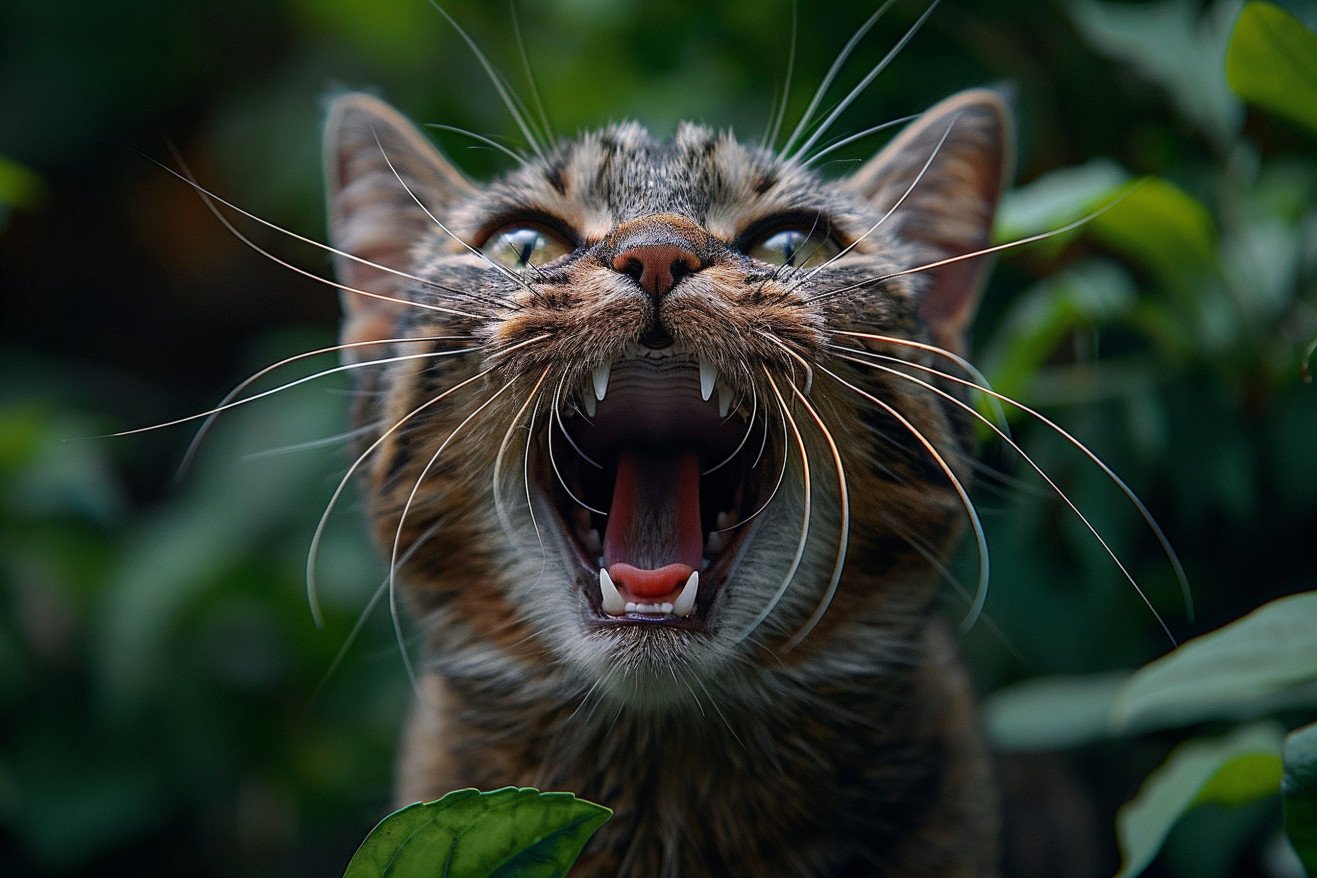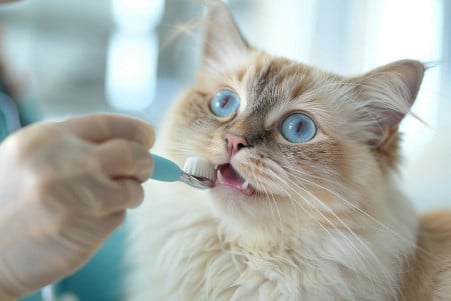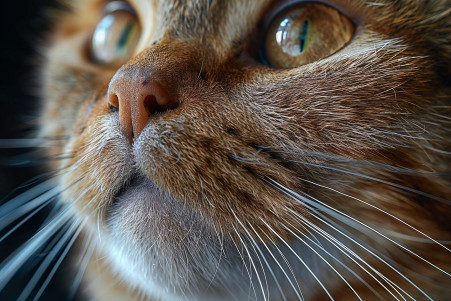How Many Teeth Do Cats Have? Exploring Feline Dental Anatomy
9 April 2024 • Updated 8 April 2024

If you've ever asked yourself how many teeth are hidden behind your cat's snarl or sweet smile, you're not alone – knowledge of feline dental anatomy can shed light on a cat's diet, behavior, and even evolution. In total, cats have 30 teeth (26 teeth as kittens) with 12 incisors, 4 canines, 10 premolars, and 4 molars – this specific combination of teeth enables cats to use their carnassial teeth and strong jaw muscles to expertly consume the flesh of their prey.
We'll break down the most recent findings from veterinary and evolutionary biology scholars to take a deep dive into the intriguing world of feline dentition. By the end, you'll have a better understanding of how a cat's unique dentition makes it possible for them to be obligate carnivores, complete with canines that are perfect for holding onto prey, and premolars and molars that are perfectly suited to cutting through flesh while ensuring bones and fur are safely consumed.
We'll also look into the evolutionary history of a cat's teeth and explain why certain breeds have different numbers and arrangements of teeth as a result of selective breeding. This knowledge will help you better understand your cat's dietary and health needs.
How many teeth do cats have?
Kitten Teething Timeline
At 3-4 weeks old, a kitten's first set of tiny incisors start to break through their gums, marking the beginning of the arrival of their 26 deciduous "baby" teeth. By 6-8 weeks, all of these sharp, needle-like milk teeth will have come in. But this is just the first phase of teething, which will culminate in the arrival of their permanent adult teeth.
Between 3-6 months old, a kitten goes through the teething process, during which their baby teeth fall out and are replaced by their larger, more durable adult teeth. The incisors are the first to come in, with the canines, premolars, and finally molars following by 6-7 months. By the end of this process, a cat will have 30 adult teeth, each with thicker enamel and longer roots than their baby teeth, making them well-suited to a lifetime of biting and chewing.
This period can be uncomfortable, and typical symptoms include drooling, a loss of appetite, and irritability as the new teeth come in. Providing safe, durable toys to chew on, like a wet washcloth that's been frozen, can help to relieve sore gums while discouraging destructive behavior. It's also important to watch for retained deciduous teeth, which can cause overcrowding in the mouth and may need to be removed by a vet.
By giving your kitten a little extra attention during this period, their new adult teeth will be ready to support them as they bite, chew, and groom for years to come. And by helping them develop good dental hygiene practices now, you'll set them up for a lifetime of good oral health.
Most Common Dental Issues in Cats and How to Prevent Them
Dental disease is one of the most common health problems in cats, with up to 90% of cats over 4 years old affected. The most common dental issues in cats are gingivitis, periodontal disease, tooth resorption, and stomatitis. All of these issues are caused by plaque, which is a sticky bacterial film that hardens into tartar, leading to gum disease and eventually tooth and bone loss.
Dental disease is one of the most common medical conditions in cats, according to the Cornell Feline Health Center. It's important to prevent these issues because advanced dental disease can be painful and lead to tooth loss and even other health issues. Regular professional cleanings and at-home care, such as daily brushing, are important for keeping your cat's mouth healthy.
At-Home Dental Care: Brushing Your Cat's Teeth
Veterinarians suggest brushing a cat's teeth at least once a day, if not every other day, to remove plaque and stop tartar from forming. VCA Animal Hospitals even says that this daily dental care is especially important since between 50-80% of cats over the age of four have some form of periodontal disease.
To brush your cat's teeth, you'll want to make sure you have a soft-bristled toothbrush that's specifically made for cats and toothpaste that's safe for pets. You should never use human toothpaste because it contains ingredients that can be toxic to cats. The Cat Friendly Homes website says that you should start by introducing your cat to the toothbrush and toothpaste and then work up to brushing their teeth. Make sure to use positive reinforcement and rewards to help your cat get used to the process.
When you're brushing your cat's teeth, make sure to focus on the outer surfaces of the large cheek teeth and canines since these are the areas where plaque is most likely to build up. Zoetis Petcare recommends brushing each side for about 30 seconds. In addition to brushing, The Wildest says that dental treats, rinses, and special diets can also help maintain your cat's oral health between dental cleanings.
Making sure that you have a regular at-home dental care routine in place and that you're taking your cat to the vet for regular check-ups is important for making sure that your cat's teeth stay healthy and that they don't develop dental problems that could cause them pain.
Evolutionary History and Genetic Differences in Cat Teeth
The unique teeth of cats are an evolutionary adaptation that helps them hunt and eat their prey. Daily Paws notes that cats' sharp canines are meant for biting and tearing, while their premolars and molars can cut through flesh and crunch through bones and fur. This level of specificity in their teeth is the same as that of the African wildcat, the wild cat species from which domestic cats are descended, and who also eat a diet of meat.
Although the number of teeth in all domestic cats is the same, Catster explains that selective breeding has led to some differences in the alignment and number of teeth in some breeds. Knowing where a cat's teeth come from evolutionarily can help cat owners better understand their pet's dietary and hunting needs.
Conclusion: The Importance of Cat Dental Care
Knowing a cat's dental anatomy and the teething process is important for ensuring proper care. Dental disease is very common in cats, with up to 90% of cats over 4 years old experiencing it, but it can be avoided with regular at-home care and professional cleanings.
If good dental care practices, including daily brushing, are started early, they can help ensure a cat's dental health for life. It's also important to make sure cats have regular veterinary care so that any dental issues can be caught and treated before they become serious. Not only will prioritizing dental care help prevent pain and tooth loss, but it will also contribute to a cat's overall health and well-being.


